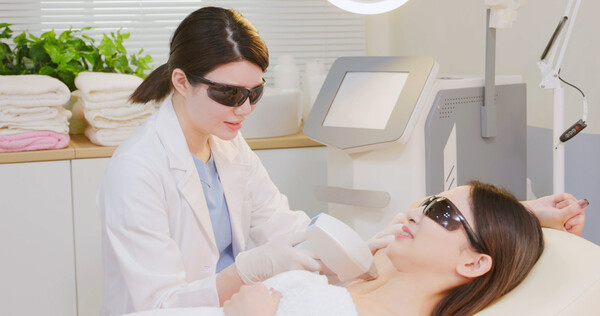Super Junior's Kim Ryeo-wook was recently named the Medical Charity Honorary Ambassador for Korea's medical tourism campaign in March. However, laser hair removal is one medical aesthetic procedure that foreigners are hesitant to receive in Korea due to the potential risk of burns.
A Peruvian national in her early thirties, who wanted to remain unnamed, shared her recent encounter at a clinic in Gangnam which left her with a burn after her appointment for a laser hair removal procedure for her facial sideburns.
"As Koreans usually don’t have very thick hair, this might not be a problem but I think this burn could have been avoided if they paid more attention to this from the start and adjusted the laser energy accordingly,” she said.
She shaved the area one day before her appointment as instructed but her hair had already grown back a bit the following day. Even though the energy was the same, the absorption was greater causing the burn.
Despite her dissatisfaction with the incident, she was quick to note that the clinic offered to rectify the problem by offering additional facial treatments until the burn disappeared.
Laser hair removal procedures usually range from 5,500 won ($4.3) to 198,000 won ($153.3) depending on the part of the body and can also differ if the client is male or female.

Why it works better on some?
In laser hair removal, the laser energy is absorbed by the melanin in the hair and transmitted down the hair shaft, disrupting the hair root growth mechanism. It is classified as a cosmetic procedure that uses intense heat from a laser to damage the hair follicles and prevent future hair growth. It targets the pigment, or melanin, in the hair follicle to achieve the desired effect.
However, this method doesn’t work well for blonde, white, or gray hair because they have less melanin. It also doesn’t work for red hair either as it contains a different type of melanin.
According to a representative from Lienjang Plastic Surgery Dermatology Korea, laser burns are rare.
“In some cases, burns may occur if the skin tone is dark because the laser may target the melanin inside the skin but not the hair follicle,” said the representative.
Conversely, the risk of burns for fair-skinned persons with dark hair is lower since the melanin levels in the surrounding skin are low.
Burns are not very common but can sometimes occur due to prolonged laser contact, accumulated residual laser gel, and darker complexions.
In this regard, it is generally recommended to cleanly shave the area within one to two days before the treatment, avoiding electric razors and tweezing, waxing, or plucking between or before sessions so the hair root remains for the laser to target.
Although the effects of the laser treatment vary per individual, it generally requires approximately 10 sessions every four to six weeks.
Laser hair removal has become a common way to remove hair as it delays the rate of hair growth, is less time-consuming, and has also become less expensive. Compared to shaving, it also makes the hair growth less thick in that region.
However, another Guyanese national living in Korea also expressed skepticism about receiving treatments in Korea for laser hair removal due to her darker skin complexion as she is well aware of the higher risks of burns for darker skin tones.
Accordingly, the representative from Liejang Plastic Surgery & Dermatology suggested, "We have performed laser treatment successfully on clients with dark complexions but we recommend coming in for a consultation with our dermatologists before treatment to determine if the laser hair removal procedure will be effective or not."
Growing demand for medical aesthetic procedures in Korea
The number of foreign patients visiting Korea has increased by 23 percent annually starting with 60,000 patients in 2009 and rising to 2.76 million in 2019, according to the latest government statistics.
According to a Korea Health Industry Development Institute (KHIDI) report in 2021, the top five most visited medical departments were integrative internal medicine, followed by plastic surgery, dermatology, medical check-up service, and obstetrics and gynecology.
Among them, aesthetic medical procedures between plastic surgery and dermatology accounted for 22 percent of all medical services for visiting foreigners, the report showed.
Earlier this year, the Ministry of Economy and Finance also announced a plan to boost domestic demand by organizing customized medical tourism packages linking to each province’s medical specialty with certain countries, while cutting airport passenger service charges.
Related articles
- [Botulinum Toxin Trends] Something borrowed, something blue, and a shot of BTX?
- Merz Aesthetics aims to lead safe BTX use with ‘global agreement’
- [Botulinum Toxin Trends] Can you really find $4 botulinum toxin in Korea?
- [Botulinum Toxin Trends] Key tips for avoiding BTX resistance
- Foreign patients visiting Korea for treatment up 70% in 2022
- ‘Korea needs to get UAE patients back to pre-Covid-19 level’
- Asan Medical Center partners with Lotte Hotel to attract international patients

